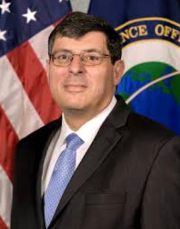NRO Director on the benefits of leveraging commercial space assets.

As U.S. near-peer competitors continue to establish a strong presence in space, the domain itself is quickly evolving from a benign to contested arena.
Today’s more advanced adversaries continue to find ways to interrupt, deny, or simply destroy U.S. assets and capabilities in space. And that’s a problem, since the communications capabilities delivered by satellites are more important than ever for our increasingly technology and network dependent military.
From being able to transmit decision-making intelligence, surveillance, and reconnaissance (ISR) data, to providing connectivity to warfighters in off-grid environments, the U.S. has countless, highly critical capabilities and solutions that solely depend on a well- defended and uninterrupted space architecture.

Dr. Christopher
Scolese
This sentiment was recently shared by Dr. Christopher Scolese, the Director of the National Reconnaissance Office (NRO), at a Schriever Spacepower Forum.
“The world is changing,” said Dr. Scolese. “We need information faster, and we need to deliver it quicker.” He explained that space is no longer the uncontested domain that it once was. From cyber threats to adversarial anti- satellite mission tests (ASMT), space is quickly becoming the next, modern battlefield.
“We have even more denied areas,” said Dr. Scolese. “We previously have been operating in a more permissive environment. And that has now gone away.” Nevertheless, Dr. Scolese made it clear that his agency is committed to supplying rapid and timely ISR when it is needed, especially to the U.S. Space Force and the U.S. Space Command. “ We’re going to find ways so that we can be efficient. We can make that happen very effectively.”
“Buy What We Can”
One resource that Dr. Scolese views as a possible solution to NRO needs is the commercial space industry.
“Buy what we can, build what we must,” he said. Dr. Scolese explained that the NRO is seeking to expand on its use of capabilities provided by industry. “We are looking for more commercial services,” he said. “What it comes down to is that the commercial market has really grown, and we’re seeing a lot of capability out there that commercial companies are providing.”
According to Dr. Scolese, one major benefit from his, “Buy what we can,” motto is the affordability factor. He explained that emerging commercial solutions are providing agencies like the NRO with an opportunity to acquire critical data “at a lower cost.”
He went on to say that the data the commercial industry provides gives the NRO the ability and advantage to share more information faster.
“The warfighter may not need the exquisite imagery,” explained Dr. Scolese. “But they need to know what’s there. And commercial gives us that opportunity.”

Dr. Scolese isn’t the only high-ranking government official who sees the value in leveraging commercial space assets, solutions, and capabilities.
“I also think that if commercial has a capability…you’re not going to get any faster than taking advantage of what you could just buy off the shelf as opposed to develop,” he said.
At another Spacepower Forum this past January, the U.S. Space Force’s Lt. Gen. B. Chance Saltzman also agreed that deploying off-the-shelf commercial capabilities would benefit the DoD.
“With the technology that’s being employed, I think we’re going to be able to leverage commercial capabilities to accomplish a subset of our missions,” said the General. “And, as we distribute those up, not only does it free up resources for us, but it creates a more resilient architecture because of the number of different places and pathways where we can get the information we need.”

The commercial satellite industry can do more than offer ISR data and imaging at a discount. Commercial satellite providers can also deliver communications and connectivity that can protect military networks from near-peer adversaries.
Creating Resiliency
Having a resilient space architecture was another topic that Dr. Scolese touched upon at the forum. He explained the critical role a resilient space architecture would play for the defense of U.S. assets and capabilities in the domain.
“A resilient proliferated, architecture gives us faster revisit times and a more responsive system,” he explained. “So, it gives us greater capability. It gives us more options to deliver what is needed to whoever is needed… We’ll have more capability to deliver more flexibility among our systems to get the information that’s needed.”
The development and deployment of a resilient space architecture is another theme top military leadership have been discussing throughout the past year. Last February, Space Force’s Chief of Space Operations, Gen John W. “Jay” Raymond explained, “We have got to shift the space architecture from a handful of exquisite capabilities that are very hard to defend to a more robust, more resilient architecture by design.”
Much like the resources industry provides for ISR and warfighting capabilities, the commercial sector can also provide the required assets and solutions that would build out a hardened and resilient space architecture.
In a recent interview with the Government Satellite Report, SES Government Solutions’ Jon Bennett, Vice President, Government Affairs, Marketing and Corporate Communications, discussed the important role commercial capabilities play in military space architectures.
“A benefit of leveraging commercial…is the security, resiliency, and redundancy it provides,” said Mr. Bennett. “When you’re able to complicate an enemy’s targeting calculus, that ensures that the built-in security features of your assets can mitigate threats at the highest level.”
He went on to explain that if the U.S. doesn’t take advantage and leverage commercial solutions and capabilities, “we are certainly putting ourselves at an extreme disadvantage to our adversaries.”
Select this link to watch Dr. Scolese’s interview in full...

David Pesgraves
This articles appeared first on GovSat and is reprinted with permission of the publication and SES-GS.
Author David Presgraves is a Staff Writer for GovSat Report, in addition to several other online publications dedicated to defense, military, and federal government agency technologies.



